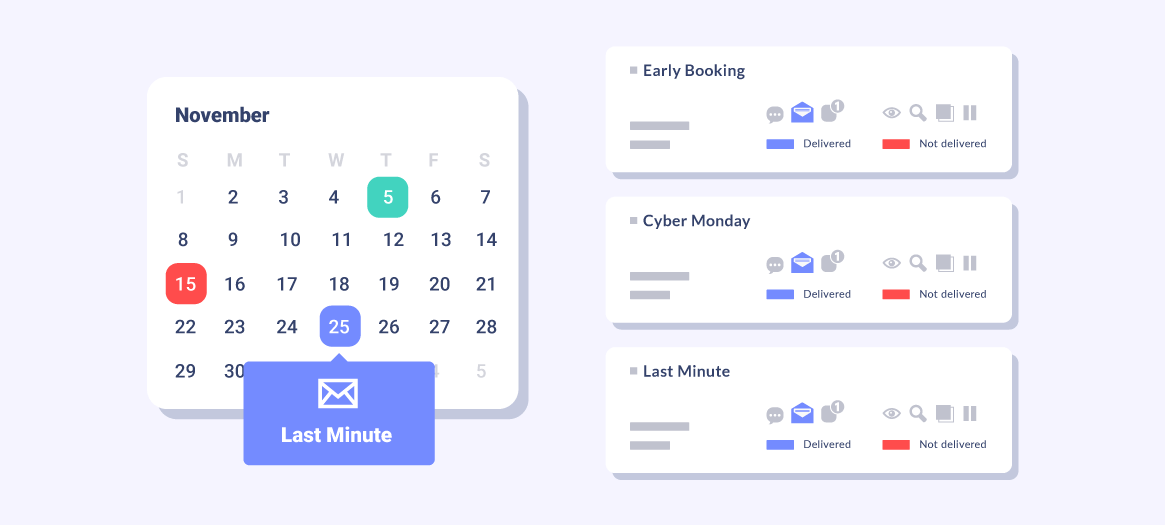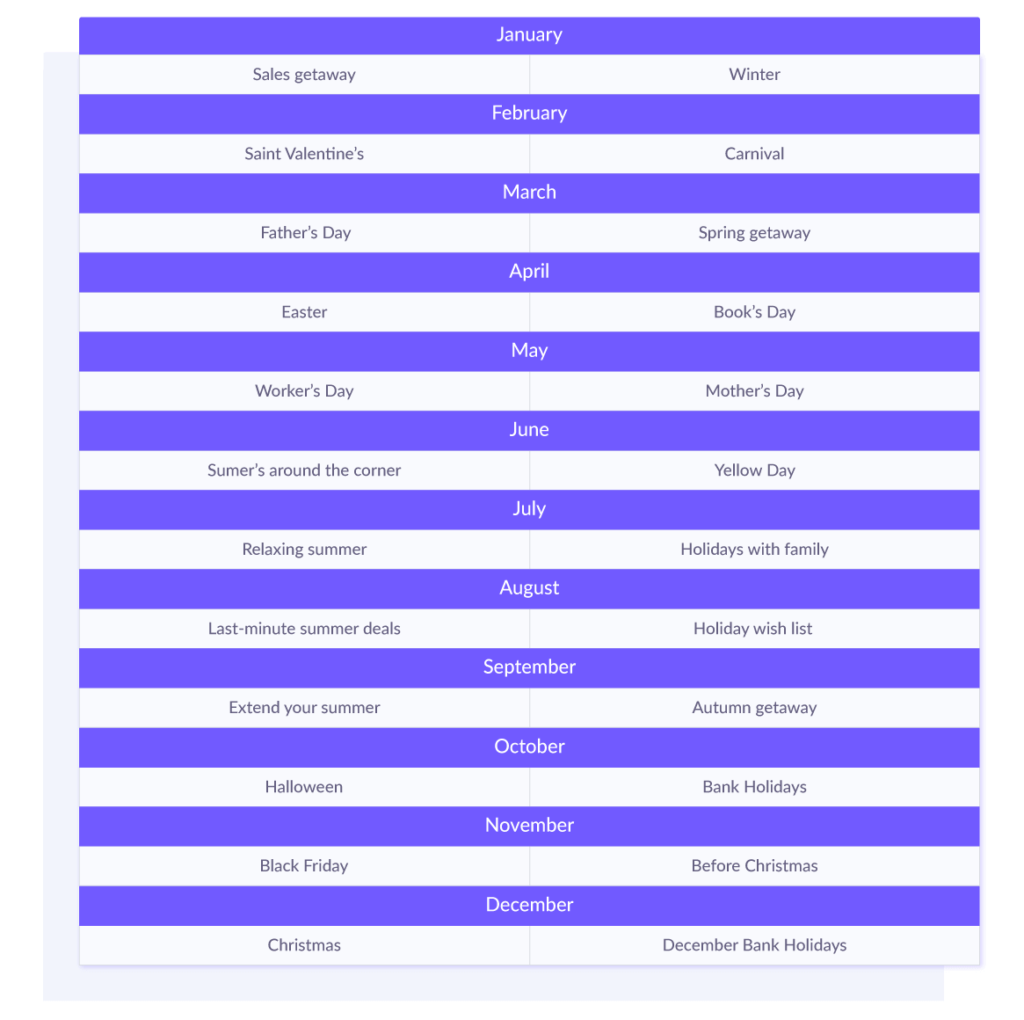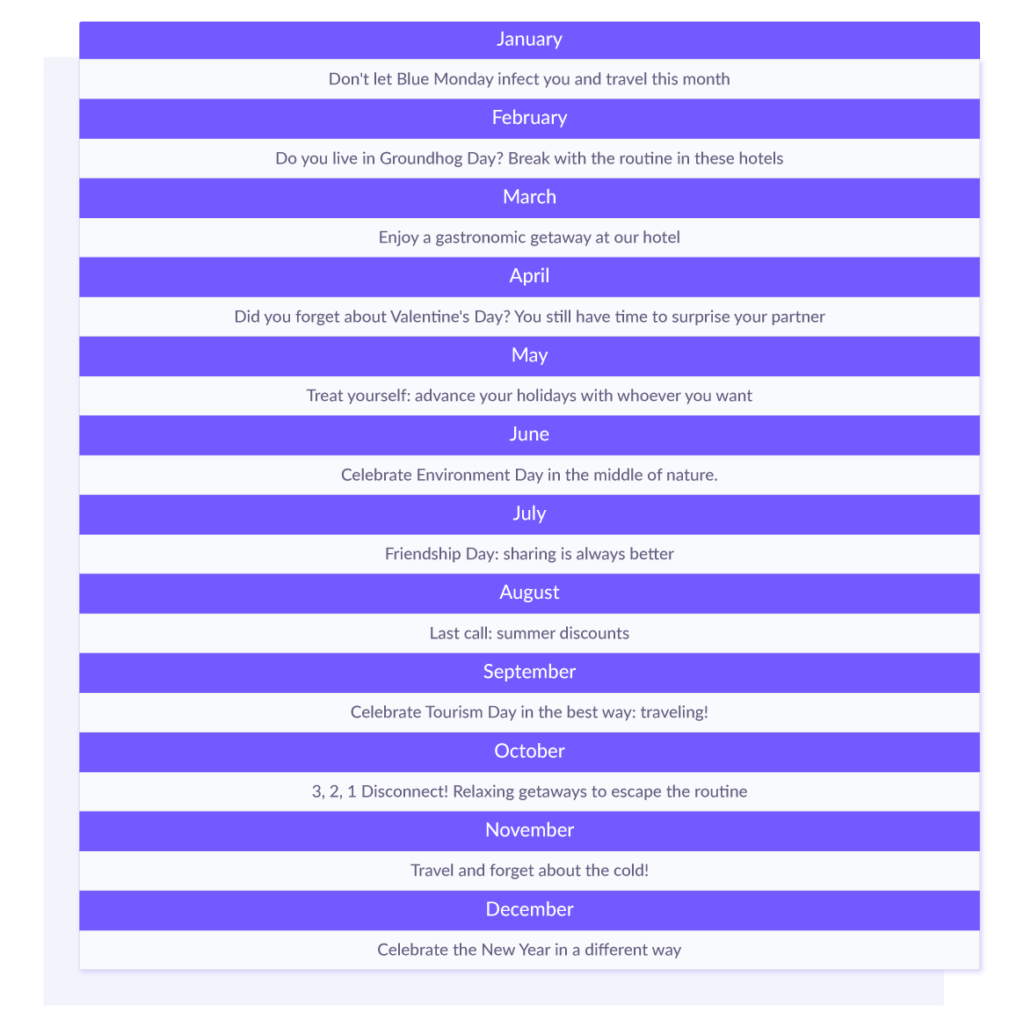
Marketing 5:00 Min read
Email Marketing Guide: How to plan email campaigns for the hotel sector from scratch. (II)
There are endless options for email marketing campaigns that can be created, highlighting the unique features of the accomodation.
In the first place, as we mentioned before, we recommend identifying those features that are associated with the accomodation: destination, category, type of traveler,… Then, it is a question of trying several to see which ones work best. However, we help you with 3 infallible ideas with which your email marketing campaigns will transmit a personalized message with good results.
Features of the destination + identity
Many travellers choose their holidays based on the tourist attractions the destination has to offer. That is why it is interesting to try to position the accommodation in relation to those points of interest. The way to convey this in an email marketing campaign is creating a link between the brand and what the local area offers.
For example, imagine a hotel group where most of its hotels are resorts located on the island of Lanzarote. We could be extra creative at the best time of the year, when there is no generalist campaign programmed, planning a campaign with the slogan “surf your holidays with us in Lanzarote”.
Creativity and design must, of course, go with the slogan of the campaign. The same exercise is totally equivalent if we create a link between nature, gastronomy or local folklore, for example, and again, the hotel brand.
“Last Minute” occasional + creative
This technique is used to motivate those hesitating, who book their holidays with poor or no prior planning. “Last minute” offers are beneficial because they enable to add an extra dose of urgency to the recipient.
You can start to create campaigns in the style of “countdown to your holidays, now or never!”, “last call for travellers to paradise” or “the sun is here, better late than never”. Urgency is one of the motivational factors that works better in marketing, and it is an advantageous decision factor too. However, in this sort of campaigns the copy is especially important, most of all the subject, because it must entice customers to open the email, as well as call to actions, because they must help to make decisions fast.
The potential of these sort of campaigns is that they can always be sent throughout the year, at specific and strategic times that will mainly depend on the type of hotel, destination and time of the year.
Customer knowledge + segmented data
The goal of these campaigns is finding trends and segments that can be grouped, but not individualised.
It is not about knowing in detail the individual tastes of each guest, since compiling this sort of very personal information is an expensive task, it takes much time as it must be entered manually and from an email marketing point of view, the return is not clear.
We recommend planning campaigns that, for example, are aimed at guests that travel with families, adults-only (couples) or solo travellers. Depending on the time of the year, it is easy to know the reason why specific groups of customers stay in the hotel: they may be business or leisure travellers. We must also consider how long in advance they book to discover booking habits, impacting at the right time.
One of the main issues, in this case, is the capability a hotel has to collect customer data, as well as the quality of the same. The success of the segmentations they can perform will highly depend on this as well as what the email marketing tool they work with enables them to do.
For these campaigns to be truly effective, it is imperative to have an efficient guest data collection system, in other words, to compile hotel data, the universe of guest data, that will enable to have a more in-depth knowledge of basic demographic and transactional data to have more detailed guest profiles that make it possible to know your target audience better.
The most basic and general campaigns are the ones that will generate most of the results, around 80 % of the total reservations. To generate the other 20 %, we must work on the so-called long tail: many specific campaigns, very segmented to obtain a few reservations with each one. But in the end, all campaigns that generate new bookings are necessary to maximise results. With a good strategy of creative campaigns as well as specific ones, we can increase the total number of annual reservations between 20 % – 30 %.
Moreover, experimenting continuously makes it possible to analyse easily those that have been the most successful, being able to replicate them in the future; this is why testing as much as possible is so important. Many of the email marketing tools available in the market enable A/B testing, a very recommendable feature to identify behavioural trends that can help you to make improvements to your campaign.
Last but not least, we must not forget that a recipient that receives a campaign and ends up booking, should not receive any additional campaigns in the coming three to six months. Otherwise, we will create the opposite effect and those who book will end up unsubscribing so they will not receive any more campaigns and we will lose the best customers campaign after campaign.
Example of email marketing planning campaigns
The first year we organise an email marketing planning for the first time tends to be the more overwhelming one because we cannot use any previous designs, copies or stats to make the right decisions and, in general, we have to create everything from scratch. What works for a hotel brand may not work for another. Urban hotels must opt for strategies different to resorts and, in general, the most important thing is knowing each hotel brand’s specific clientele and applying the modifications needed.
The important thing is starting without trying to build the best email marketing strategy possible during the first year. It is something that is built year after year, and good results and not so good results enable us to learn.
FIRST YEAR
Sending one or two monthly campaigns, choosing the most convenient ones according to the options from previous inspiration. On our side, we can offer this selection which always gives good results.
It is important to remember that the subject of each campaign must always be personalised with the name of the recipient. Always segment per the main representative languages of each hotel brand.

SECOND YEAR
Maintain the campaigns of the first year, except if any of them has not performed well (for example, if it has not generated any bookings). Add between 10 and 20 annual campaigns specific for bank holidays and local festivities related to the hotel brand’s most representative nationalities. By doing so, we can attract repeat guests who are planning short breaks on those dates.
Add five and ten annual segmented campaigns with transactional data (campaigns for guests with family, repeat guests, as per room type…).

THIRD YEAR
With data and results to analyse from two previous years, it would already be possible to make the right decisions, what works and what does not for the hotel brand in question. To reinforce the results of each campaign, it would be ideal to create automated follow-up emails. These sort of event-based emails have a very positive impact on the final results, since they direct the recipient in an automated way to the final part of the bottleneck.
>> In the next article, we will discuss in detail all there is to know about automated follow-up emails. These mailings are based on the behaviour of the recipient and can increase the number or reservations up to 30%!